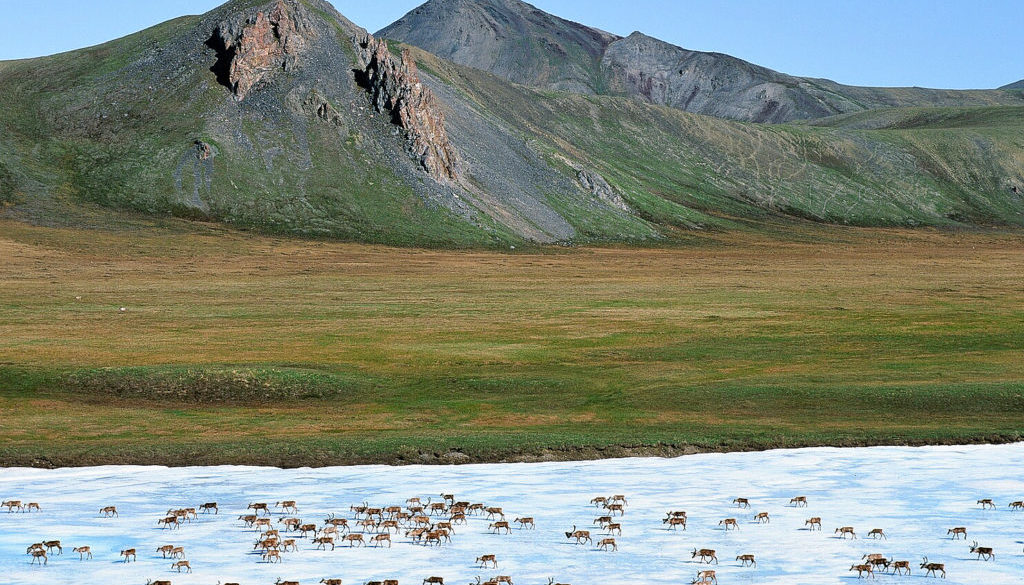I read the Draft Environmental Impact Statement on drilling in the Arctic Refuge, so you don’t have to.
Header Image: Ken Madsen
Written by: Malkolm Boothroyd, Campaigns Coordinator
Just before the Christmas holidays began, the U.S. Bureau of Land Management released its Draft Environmental Impact Statement (Draft EIS) on oil and gas leasing in the Arctic National Wildlife Refuge. While the rest of my family was decorating trees I was reading about pipelines and processing facilities on the fragile Arctic tundra. While my nieces and nephew put out goodies for reindeer, I was thinking about the Porcupine caribou herd — and how they would suffer if drilling was ever allowed in their calving grounds.
I’ve read (most of) the 756 page statement, so that you don’t have to. The U.S. Government is rushing to authorize oil and gas drilling, and it shows in the shoddiness of its environmental review. Now it’s time for everyone to comment on how terrible the Draft EIS is. CPAWS Yukon has made it easy — you can add your name to our open letter and send it to the Bureau of Land Management with a single click.
Our platform also makes it easy to personalize your letter. If you have time, I’d love for you to add some specifics about why the Draft EIS is so inadequate. As a pointer here are my five biggest problems with the Draft EIS.
- The Draft EIS doesn’t acknowledge Gwich’in communities within Canada when determining which communities would be “appreciably affected” by changes to Porcupine caribou populations or movements. The U.S. Government needs to comprehensively evaluate the social, cultural and health impacts on all Gwich’in communities that rely on the Porcupine caribou herd.
- The Draft EIS downplays how important the Arctic Refuge is for the Porcupine caribou herd, and doesn’t properly address the importance of the Coastal Plain for caribou after they calve. The Draft EIS states that the Porcupine caribou herd would not experience major impacts from drilling, but provides almost no evidence to back up this claim. The Draft EIS fails to provide a quantitative analysis of what could happen to the herd if drilling occurs. Tell the U.S. Government that 100% of the Coastal Plain is critical calving and post-calving habitat for the Porcupine caribou. The U.S. Government must undertake a robust, cautionary and evidence-based approach to studying the impacts of drilling on the Porcupine caribou herd.
- The Porcupine caribou herd is critical for ecosystems, communities and economies across northern Canada. Drilling in the Arctic Refuge could have serious transboundary (cross-border) impacts on Canada. The Draft EIS fails to consider transboundary impacts of oil and gas drilling in the Arctic Refuge. The term ‘transboundary’ doesn’t even show up. Canadians need to tell the U.S. Government to comprehensively evaluate the transboundary impacts of drilling in the Arctic Refuge.
- The Draft EIS fails to adequately address cumulative impacts. The cumulative effects assessment on the Porcupine caribou herd is a mere five sentences long, while the polar bear assessment devotes a single sentence to climate change. Tell the U.S. Government that such superficial assessments of cumulative impacts are unacceptable.
- The scenarios offered by the Draft EIS are development, development, or development. Each scenario offered by the U.S. Government opens more of the Arctic Refuge to oil and gas leasing than the minimum required under the tax bill that originally opened the Refuge to drilling. Two scenarios open virtually the entirety of the Coastal Plain to leasing, while the third scenario offers over 1 million acres. The Arctic Refuge is too important for oil drilling, anywhere.
It’s critical that Canadians tell the U.S. Government just how flawed the Draft EIS is. Putting our concerns on the public record will help hold the U.S. accountable to its environmental laws.
Take action here: https://action.cpaws.org/page/35106/action/1
P.S. once you write your comment, you get to see a gallery of adorable baby Arctic animals called “Puffy and Fluffy” 
To learn about the Porcupine caribou herd and their journey, click here.


